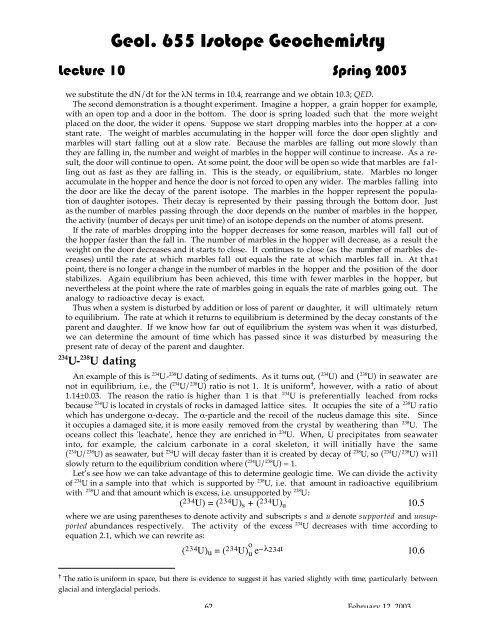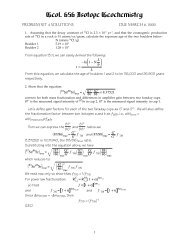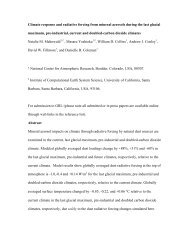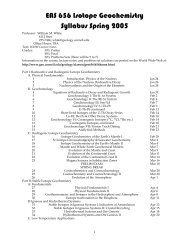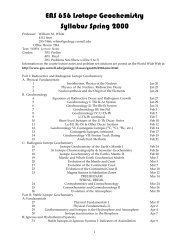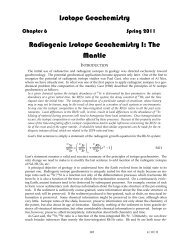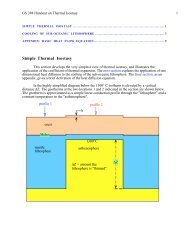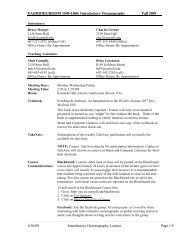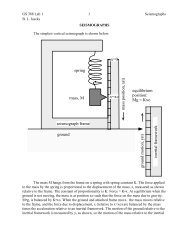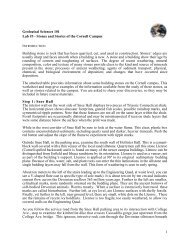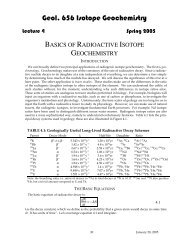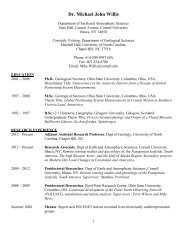Lecture 10: Geochronology VI: U-Th decay series dating
Lecture 10: Geochronology VI: U-Th decay series dating
Lecture 10: Geochronology VI: U-Th decay series dating
You also want an ePaper? Increase the reach of your titles
YUMPU automatically turns print PDFs into web optimized ePapers that Google loves.
Geol. 655 Isotope Geochemistry<strong>Lecture</strong> <strong>10</strong> Spring 2003we substitute the dN/dt for the lN terms in <strong>10</strong>.4, rearrange and we obtain <strong>10</strong>.3; QED.<strong>Th</strong>e second demonstration is a thought experiment. Imagine a hopper, a grain hopper for example,with an open top and a door in the bottom. <strong>Th</strong>e door is spring loaded such that the more weightplaced on the door, the wider it opens. Suppose we start dropping marbles into the hopper at a constantrate. <strong>Th</strong>e weight of marbles accumulating in the hopper will force the door open slightly andmarbles will start falling out at a slow rate. Because the marbles are falling out more slowly thanthey are falling in, the number and weight of marbles in the hopper will continue to increase. As a result,the door will continue to open. At some point, the door will be open so wide that marbles are fallingout as fast as they are falling in. <strong>Th</strong>is is the steady, or equilibrium, state. Marbles no longeraccumulate in the hopper and hence the door is not forced to open any wider. <strong>Th</strong>e marbles falling intothe door are like the <strong>decay</strong> of the parent isotope. <strong>Th</strong>e marbles in the hopper represent the populationof daughter isotopes. <strong>Th</strong>eir <strong>decay</strong> is represented by their passing through the bottom door. Justas the number of marbles passing through the door depends on the number of marbles in the hopper,the activity (number of <strong>decay</strong>s per unit time) of an isotope depends on the number of atoms present.If the rate of marbles dropping into the hopper decreases for some reason, marbles will fall out ofthe hopper faster than the fall in. <strong>Th</strong>e number of marbles in the hopper will decrease, as a result theweight on the door decreases and it starts to close. It continues to close (as the number of marbles decreases)until the rate at which marbles fall out equals the rate at which marbles fall in. At thatpoint, there is no longer a change in the number of marbles in the hopper and the position of the doorstabilizes. Again equilibrium has been achieved, this time with fewer marbles in the hopper, butnevertheless at the point where the rate of marbles going in equals the rate of marbles going out. <strong>Th</strong>eanalogy to radioactive <strong>decay</strong> is exact.<strong>Th</strong>us when a system is disturbed by addition or loss of parent or daughter, it will ultimately returnto equilibrium. <strong>Th</strong>e rate at which it returns to equilibrium is determined by the <strong>decay</strong> constants of theparent and daughter. If we know how far out of equilibrium the system was when it was disturbed,we can determine the amount of time which has passed since it was disturbed by measuring thepresent rate of <strong>decay</strong> of the parent and daughter.234 U- 238 U <strong>dating</strong>An example of this is 234 U- 238 U <strong>dating</strong> of sediments. As it turns out, ( 234 U) and ( 238 U) in seawater arenot in equilibrium, i.e., the ( 234 U/ 238 U) ratio is not 1. It is uniform † , however, with a ratio of about1.14±0.03. <strong>Th</strong>e reason the ratio is higher than 1 is that 234 U is preferentially leached from rocksbecause 234 U is located in crystals of rocks in damaged lattice sites. It occupies the site of a 238 U ratiowhich has undergone a-<strong>decay</strong>. <strong>Th</strong>e a-particle and the recoil of the nucleus damage this site. Sinceit occupies a damaged site, it is more easily removed from the crystal by weathering than 238 U. <strong>Th</strong>eoceans collect this 'leachate', hence they are enriched in 234 U. When, U precipitates from seawaterinto, for example, the calcium carbonate in a coral skeleton, it will initially have the same( 234 U/ 238 U) as seawater, but 234 U will <strong>decay</strong> faster than it is created by <strong>decay</strong> of 238 U, so ( 234 U/ 238 U) willslowly return to the equilibrium condition where ( 234 U/ 238 U) = 1.Let’s see how we can take advantage of this to determine geologic time. We can divide the activityof 234 U in a sample into that which is supported by 238 U, i.e. that amount in radioactive equilibriumwith 238 U and that amount which is excess, i.e. unsupported by 238 U:( 234 U) = ( 234 U) s + ( 234 U) u <strong>10</strong>.5where we are using parentheses to denote activity and subscripts s and u denote supported and unsupportedabundances respectively. <strong>Th</strong>e activity of the excess 234 U decreases with time according toequation 2.1, which we can rewrite as:( 234 U) u = ( 234 U) o u e-l 234t <strong>10</strong>.6† <strong>Th</strong>e ratio is uniform in space, but there is evidence to suggest it has varied slightly with time, particularly betweenglacial and interglacial periods.62 February 12, 2003


